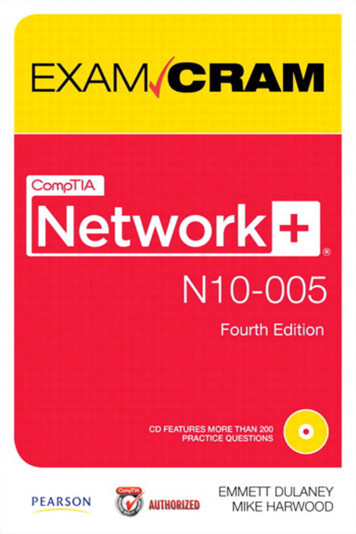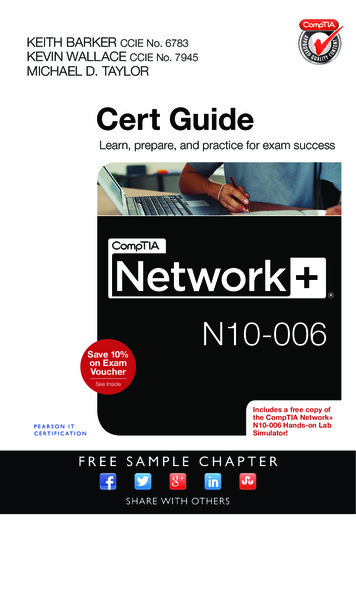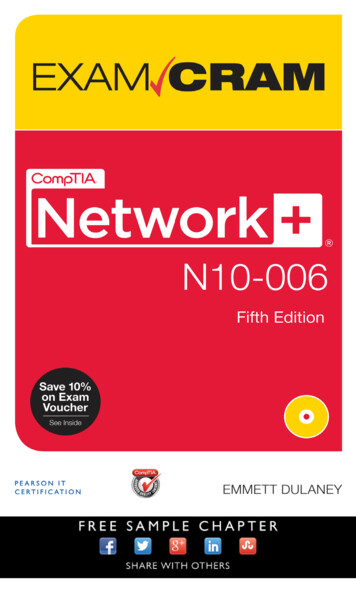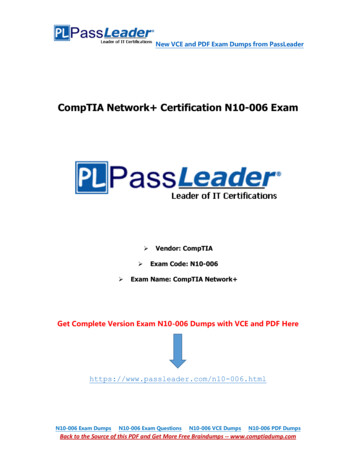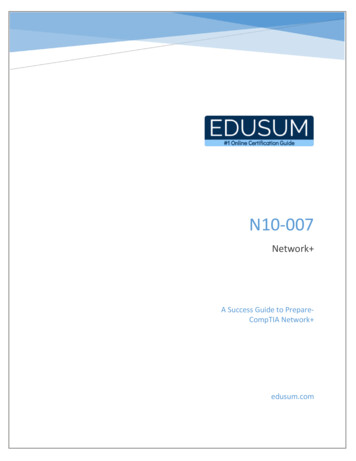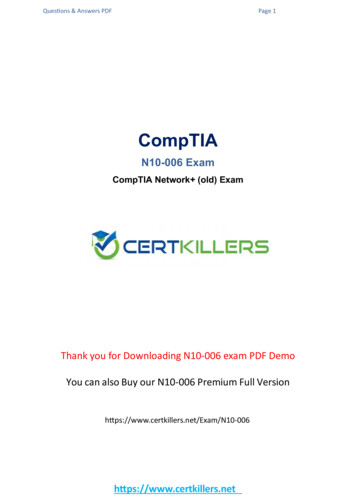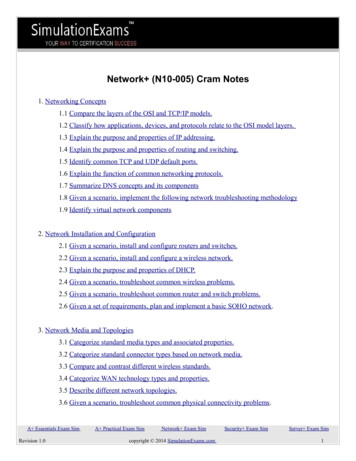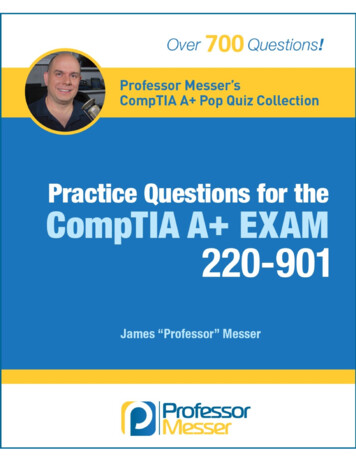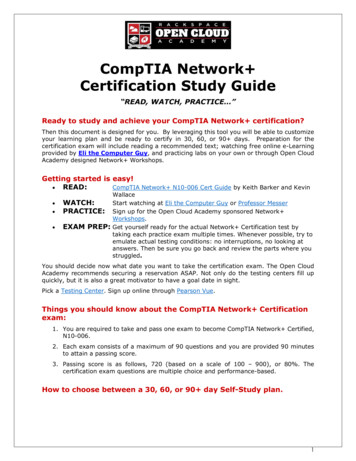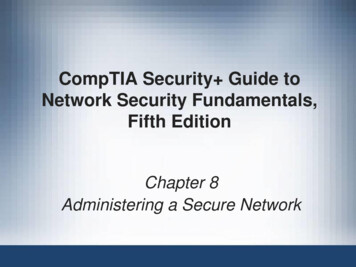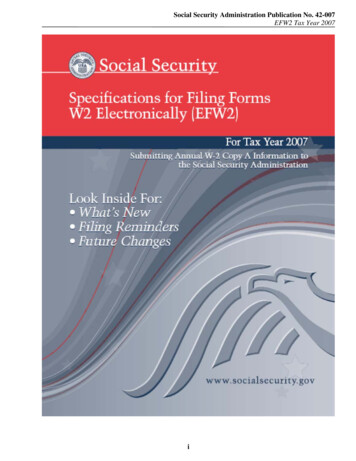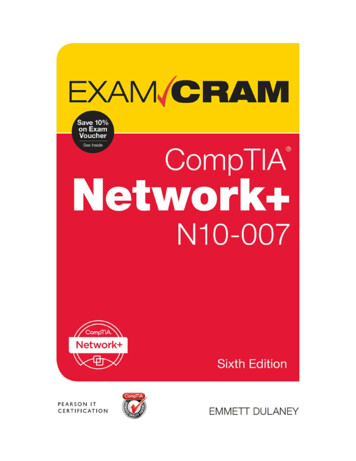
Transcription
Hiva-Network.Com
About This E-BookEPUB is an open, industry-standard format for e-books. However, support for EPUBand its many features varies across reading devices and applications. Use your deviceor app settings to customize the presentation to your liking. Settings that you cancustomize often include font, font size, single or double column, landscape or portraitmode, and figures that you can click or tap to enlarge. For additional information aboutthe settings and features on your reading device or app, visit the device manufacturer’sWeb site.Many titles include programming code or configuration examples. To optimize thepresentation of these elements, view the e-book in single-column, landscape mode andadjust the font size to the smallest setting. In addition to presenting code andconfigurations in the reflowable text format, we have included images of the code thatmimic the presentation found in the print book; therefore, where the reflowable formatmay compromise the presentation of the code listing, you will see a “Click here to viewcode image” link. Click the link to view the print-fidelity code image. To return to theprevious page viewed, click the Back button on your device or app.
CompTIA Network N10-007Sixth EditionEmmett Dulaney
CompTIA Network N10-007 Exam CramCopyright 2018 by Pearson Education, Inc.All rights reserved. No part of this book shall be reproduced, stored in a retrievalsystem, or transmitted by any means, electronic, mechanical, photocopying, recording,or otherwise, without written permission from the publisher. No patent liability isassumed with respect to the use of the information contained herein. Although everyprecaution has been taken in the preparation of this book, the publisher and authorassume no responsibility for errors or omissions. Nor is any liability assumed fordamages resulting from the use of the information contained herein.ISBN-13: 978-0-7897-5875-0ISBN-10: 0-7897-5875-XLibrary of Congress Control Number: 2017960636Printed in the United States of America01 18TrademarksAll terms mentioned in this book that are known to be trademarks or service marks havebeen appropriately capitalized. Pearson IT Certification cannot attest to the accuracy ofthis information. Use of a term in this book should not be regarded as affecting thevalidity of any trademark or service mark.CompTIA is a registered trademark of CompTIA, Inc.Warning and DisclaimerEvery effort has been made to make this book as complete and as accurate as possible,but no warranty or fitness is implied. The information provided is on an “as is” basis.The author and the publisher shall have neither liability nor responsibility to any personor entity with respect to any loss or damages arising from the information contained inthis book.Special SalesFor information about buying this title in bulk quantities, or for special salesopportunities (which may include electronic versions; custom cover designs; andcontent particular to your business, training goals, marketing focus, or brandinginterests), please contact our corporate sales department at corpsales@pearsoned.comor (800) 382-3419.For government sales inquiries, please contact governmentsales@pearsoned.com.
For questions about sales outside the U.S., please contact intlcs@pearson.com.Editor-in-ChiefMark TaubProduct Line ManagerBrett BartowAcquisitions EditorMichelle NewcombDevelopment EditorEllie BruManaging EditorSandra SchroederSenior Project EditorTonya SimpsonCopy EditorBarbara HachaIndexerErika MillenProofreaderAbigail ManheimTechnical EditorChris CraytonPublishing CoordinatorVanessa EvansCover DesignerChuti PrasertsithCompositorcodeMantraHiva-Network.Com
Contents at a GlanceIntroductionCHAPTER 1 Introduction to Networking TechnologiesCHAPTER 2 Models, Ports, Protocols, and Networking ServicesCHAPTER 3 Addressing, Routing, and SwitchingCHAPTER 4 Network Components and DevicesCHAPTER 5 WAN TechnologiesCHAPTER 6 Cabling SolutionsCHAPTER 7 Wireless SolutionsCHAPTER 8 Cloud Computing and VirtualizationCHAPTER 9 Network OperationsCHAPTER 10 Network SecurityCHAPTER 11 Network TroubleshootingGlossaryIndex
Table of ContentsIntroductionCHAPTER 1:Introduction to Networking TechnologiesWired and Wireless Network TopologiesBus TopologyRing TopologyStar TopologyWired Mesh TopologyWireless TopologiesHybrid TopologiesNetwork TypesLANsWLANsWANsMANsCANsSANsPANsIoT TechnologiesZ-WaveAnt BluetoothNFCIRRFID802.11The Magic Behind 802.11n and 802.11acA Summary of 802.11 Wireless StandardsWhat’s Next?CHAPTER 2:Models, Ports, Protocols, and Networking ServicesThe OSI Networking ModelThe OSI Seven-Layer Model
Comparing OSI to the Four-Layer TCP/IP ModelIdentifying the OSI Layers at Which Various Network Components OperatePorts and ProtocolsConnection-Oriented Protocols Versus Connectionless ProtocolsInternet ProtocolTransmission Control ProtocolUser Datagram ProtocolFile Transfer ProtocolSecure File Transfer ProtocolTrivial File Transfer ProtocolSimple Mail Transfer ProtocolHypertext Transfer ProtocolHypertext Transfer Protocol SecurePost Office Protocol Version 3/Internet Message Access Protocol Version 4TelnetSecure ShellInternet Control Message ProtocolNetwork Time ProtocolLightweight Directory Access ProtocolH.323Simple Network Management ProtocolSession Initiation ProtocolRemote Desktop ProtocolServer Message BlockUnderstanding Port FunctionsARP and RARPNetwork ServicesDomain Name Service (DNS)The DNS NamespaceTypes of DNS EntriesDNS RecordsDNS in a Practical ImplementationDynamic Host Configuration ProtocolThe DHCP ProcessDHCP and DNS SuffixesDHCP Relays and IP HelpersIP Address ManagementNetwork Time ProtocolWhat’s Next?
CHAPTER 3:Addressing, Routing, and SwitchingIP AddressingIPv4IP Address ClassesSubnet Mask AssignmentSubnettingIdentifying the Differences Between IPv4 Public and Private NetworksClassless Interdomain RoutingDefault GatewaysVirtual IPIPv4 Address TypesIPv6 AddressingComparing IPv4 and IPv6 AddressingAssigning IP AddressesIdentifying MAC AddressesNAT, PAT, SNAT, and DNATManaging TCP/IP Routing and SwitchingThe Default GatewayRouting TablesStatic RoutingSwitching MethodsSoftware-Defined NetworkingDynamic RoutingNetwork TrafficRouting MetricsVirtual Local-Area NetworksThe Spanning Tree ProtocolInterface Configuration and Switch ManagementTrunkingPort MirroringPort AuthenticationPower over EthernetDMZMAC Address TableSwitch ManagementManaged and UnmanagedQuality of ServiceTraffic ShapingHiva-Network.Com
Access Control ListsWhat’s Next?CHAPTER 4:Network Components and DevicesCommon Network DevicesFirewallRouterSwitchHubBridgeModemsWireless Access PointMedia ConverterWireless Range ExtenderVoIP EndpointNetwork Devices SummaryAdvanced Networking DevicesMultilayer SwitchWireless ControllerLoad BalancerIDS/IPSProxy ServerVPN ConcentratorAAA/RADIUS ServerUTM Appliances and NGFW/Layer 7 FirewallsVoIP PBX and GatewayContent FilterWhat’s Next?CHAPTER 5:WAN TechnologiesWAN TechnologiesIntegrated Services Digital NetworkLeased LinesFiber, SONET, and OCx LevelsFrame RelayAsynchronous Transfer ModeCopper Versus FiberOther WAN Technologies
Internet Access TechnologiesDSL Internet AccessCable BroadbandBroadband Security ConsiderationsDial-upThe Public Switched Telephone NetworkSatellite Internet AccessWireless Internet AccessTermination PointsWhat’s Next?CHAPTER 6:Cabling SolutionsGeneral Media ConsiderationsBroadband Versus Baseband TransmissionsSimplex, Half-Duplex, and Full-Duplex ModesData Transmission RatesTypes of Network MediaTypes of Media ConnectorsMedia Couplers/Converters568A and 568B Wiring StandardsStraight-Through Versus Crossover CablesRollover and Loopback CablesComponents of Wiring DistributionEthernet Deployment StandardsTroubleshooting Common Wired Connectivity rtIncorrect Pin-OutIncorrect Cable TypesBad PortTransceiver MismatchTX/RX ReversedDuplex/Speed MismatchDamaged CablesBent Pins
BottlenecksVLAN MismatchNetwork Connection LED Status IndicatorsWhat’s Next?CHAPTER 7:Wireless SolutionsUnderstanding Wireless BasicsWireless Channels and FrequenciesCellular AccessSpeed, Distance, and BandwidthChannel Site SurveysEstablishing Communications Between Wireless DevicesConfiguring the Wireless ConnectionTroubleshooting Wireless IssuesFactors Affecting Wireless SignalsTroubleshooting AP CoverageWhat’s Next?CHAPTER 8:Cloud Computing and VirtualizationCloud ConceptsSoftware as a ServicePlatform as a ServiceInfrastructure as a ServiceOther Types of ServicesPrivate CloudPublic CloudHybrid CloudConnectivity MethodsSecurity Implications and ConsiderationsThe Relationship Between ResourcesVirtualization and Storage-Area NetworksVirtualizationStorage-Area NetworksWhat’s Next?CHAPTER 9:
Network OperationsDocumentation ManagementWiring and Port LocationsPhysical and Logical Network DiagramsBaselinesPolicies, Procedures, Configurations, and RegulationsLabelingBusiness Continuity and Disaster RecoveryBackupsBackup Best PracticesUsing Uninterruptible Power SuppliesAlternatives to UPSHot, Warm, and Cold SitesHigh Availability and Recovery ConceptsMonitoring Network PerformanceCommon Reasons to Monitor NetworksSNMP MonitorsPacket SniffersThroughput TestingPort ScannersVulnerability ScannersNetwork Performance, Load, and Stress TestingTracking Event LogsRemote AccessRemote File AccessVPNsSite-to-Site and Client-to-SiteHTTPS/Management URLOut-of-Band ManagementWhat’s Next?CHAPTER 10:Network SecurityPhysical Security and Device HardeningAdding Physical Security to the MixTwo-Factor and Multifactor AuthenticationSecured Versus Unsecured ProtocolsAdditional Device HardeningAuthentication and Access ControlsHiva-Network.Com
Mandatory Access ControlDiscretionary Access ControlRule-Based Access ControlRole-Based Access ControlRADIUS and TACACS Kerberos AuthenticationLocal AuthenticationLightweight Directory Access ProtocolUsing CertificatesAuditing and LoggingMultifactor Authentication FactorsAccess ControlSecuring Wireless NetworksWPA, WPA2, TKIP-RC4, and CCMP-AESWireless Authentication and AuthorizationShared, Preshared, and Open KeysCommon Networking AttacksDenial-of-Service and Distributed Denial-of-Service AttacksOther Common AttacksVulnerabilities and PreventionMitigation TechniquesSignature ManagementDevice HardeningChange Native VLANSwitch and Port ProtectionDemilitarized Zones (Perimeter Network)VLAN Network SegmentationPrivileged User AccountFile Integrity MonitoringRole SeparationUsing ACLs to Restrict AccessHoneypots and HoneynetsPenetration TestingWhat’s Next?CHAPTER 11:Network TroubleshootingTroubleshooting Steps and ProceduresIdentify the ProblemEstablish a Theory of Probable Cause
Test the Theory to Determine CauseEstablish a Plan of ActionImplement the Solution or EscalateVerify Full System FunctionalityDocument the Findings, Actions, and OutcomesHardware and Software Troubleshooting ToolsWire Crimpers, Strippers, and SnipsTone Generator and ProbesLoopback AdapterProtocol AnalyzerMedia/Cable TestersTDR and OTDRMultimeterSpectrum AnalyzerPacket SniffersPort ScannerWi-Fi AnalyzerBandwidth Speed Tester and Looking GlassesEnvironmental MonitorsCommand-Line Troubleshooting ToolsThe Trace Route Utility (tracert/traceroute)pingARPThe netstat CommandipconfigifconfignslookupdigThe tcpdump CommandThe route UtilitynmapTroubleshooting Common Network Service IssuesCommon Problems to Be Aware OfHardware FailureWhat’s Next?GlossaryIndex
About the AuthorEmmett Dulaney (CompTIA Network , Cloud , Security , A , and others) is theauthor of numerous books on certifications and operating systems. He is a columnist forCertification Magazine and a professor at a small university. He is also the author ofCompTIA A Complete Study Guide and CompTIA Security Study Guide.Hiva-Network.Com
DedicationFor Wolfgang—Emmett Dulaney
AcknowledgmentsAn enormous amount of credit for this book goes to Christopher A. Crayton, withoutwhom this edition would be only a shadow of what it is. It was an honor to work withhim again, and I owe him enormous gratitude. Thanks are also due to Mike Harwood,who wrote the first few editions, and to the team of talented individuals at Pearson whowork behind the scenes and make each title the best it can be.—Emmett Dulaney
About the Technical EditorChris Crayton (MCSE) is an author, technical consultant, and trainer. Formerly, heworked as a computer technology and networking instructor, information securitydirector, network administrator, network engineer, and PC specialist. Chris has authoredseveral print and online books on PC repair, CompTIA A , CompTIA Security , andMicrosoft Windows. He has also served as technical editor and content contributor onnumerous technical titles for several of the leading publishing companies. Chris holdsnumerous industry certifications, has been recognized with many professional teachingawards, and has served as a state-level SkillsUSA competition judge.
We Want to Hear from You!As the reader of this book, you are our most important critic and commentator. We valueyour opinion and want to know what we’re doing right, what we could do better, whatareas you’d like to see us publish in, and any other words of wisdom you’re willing topass our way.We welcome your comments. You can email or write to let us know what you did ordidn’t like about this book—as well as what we can do to make our books better.Please note that we cannot help you with technical problems related to the topic of thisbook.When you write, please be sure to include this book’s title and author as well as yourname and email address. We will carefully review your comments and share them withthe author and editors who worked on the book.Email: feedback@pearsonitcertification.comMail:Pearson IT CertificationATTN: Reader Feedback800 East 96th StreetIndianapolis, IN 46240 USAHiva-Network.Com
Re
CompTIA Network N10-007 . CHAPTER 1 Introduction to Networking Technologies CHAPTER 2 Models, Ports, Protocols, and Networking Services CHAPTER 3 Addressing, Routing, and Switching CHAPTER 4 Network Components and Devices CHAPTER 5 WAN Technologies CHAPTER 6 Cabling Solutions CHAPTER 7 Wireless Solutions CHAPTER 8 Cloud Computing and Virtualization

